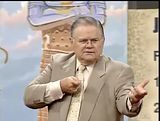|
The Birth, Near Death, Rebirth, and Online Explosion at the late Jerry Falwell's Liberty University
The little experiment exceeded all expectations "The little experiment that Falwell started in his hometown is a pretty big deal now, and the residential campus [which accommodates 14,000 students] here does not begin to tell the story," The Chronicle of Higher Education's Jack Stripling wrote in a story headlined "An Online Kingdom Come: How Liberty U. became an unexpected model for the future of higher education." "Liberty's online program boasts nearly 65,000 students, more than any other nonprofit college in the United States, according to federal data. Only the University of Phoenix, the for-profit behemoth with an enrollment of 207,000, trumps Liberty." Liberty's unprecedented online growth Since Rev. Falwell's death nearly eight years ago, the university has come under the leadership of Jerry L. Falwell Jr. Although it has experienced its fair share of campus controversies and internal problems, when it comes to its online project, Liberty has few peers. Unlike many other colleges and universities grappling with the question of how to design their online education projects, at Liberty the question is how much bigger of a role it will play. "From 2004-5 to 2013-14, Liberty University increased the number of its online students by more than 740 percent, with double-digit growth in eight of the past nine years," Stripling reported. Liberty's online growth, according to Stripling, is a product of visionary leadership and an "aggressive marketing approach, which feeds a voracious appetite for worldwide online expansion, [which] might strike some as the corporatization of academe run amok. But there is no denying that the university has carved out a distinct online identity in a relatively new market and created an Internet education machine that generates revenues any college would welcome." It is also a product of the university being able to rake in hundreds of millions of dollars from America's taxpayers. As Stripling pointed out, "the frontline of Liberty's online-recruitment operation" takes place "inside the River Ridge Mall, in what used to be a Sears, [where] ... [m]ore than 800 employees work ... crammed together in row upon row of cubicles." Telemarketing, data crunching; selling students on Liberty The operation is run like a standard telemarketing call-center. Employees scour lists of students who have expressed an interest in the school, they make the calls, "aim[ing] to keep [them] to an average of seven to 10 minutes." Data crunching is also standard operating procedure: "Federal rules bar colleges from paying recruiters solely for the number of students they enroll, because such incentives have led to deceptive marketing practices. But Liberty [officials] ... see[s] whether agents are getting students in the door. How long did a call take? How many times was a person put on hold? Why? All of those data points, rigorously tracked by Liberty, are 'KPIs,' [Key Performance Indicators]" Phillip Milakovic, who spent five years working in Liberty's call center, including as an associate director of admissions and is now digital-media manager at the Tribeca Marketing Group, where he advises colleges, told Stripling. Far from its days of teetering on the precipice of financial ruin, these days the university has more than $1 billion in reserves. "Moody's Investors Service, which has a grim view of the financial prospects of many liberal-arts colleges, has described Liberty as a 'true outlier' for its enviable market position," Stripling reported. "From 2008 to 2012, when most colleges were reeling from the recession, Liberty's operating revenues grew by 630 percent, Moody's reported." In a 2013 report, Moody's citied Liberty's "remarkable momentum in revenue growth and cash flow from operations." "We came to the realization over the last 25 yea | |||||||||||




 print page
print page